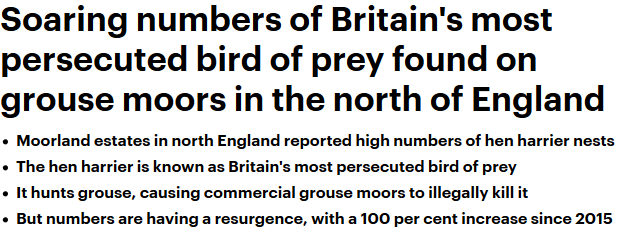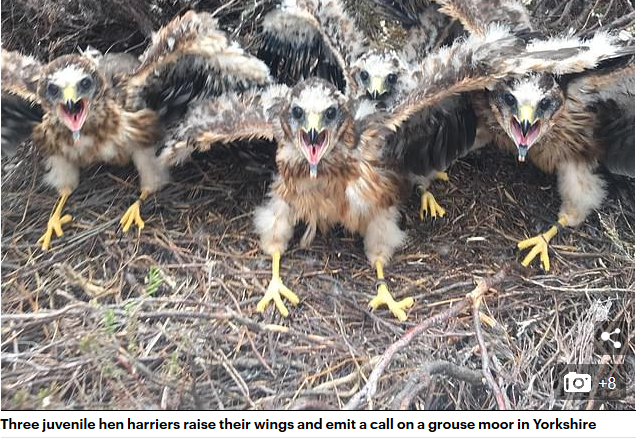

The Daily Mail online have simply cut and pasted the Moorland Association’s news release – with all its errors and misrepresentations – see here.
We are supposed to think that a dozen pairs of Hen Harriers on English grouse moors (some of which are not grouse moors) is a ‘high’ number whereas there should be treble figures of them!
‘Tell the common people that they are lucky that we have let any Hen Harriers in and they should be grateful‘ might have said a spokesperson for the Moorland Association if caught on a truthful day.
But the ‘Staff reporter’ (I’m not surprised no-one would put their name to such a story) did work hard at adding more errors to the piece (the date since when Hen Harriers have been protected, the identity of the species seen in San Francisco Bay, the population size of Hen Harriers in the last survey and the date of that survey and a bunch of typos and poor wording).
But the best error of all is that the Daily Mail can’t count;

Well, the story never did add up, did it?
[registration_form]
Now we all know that Amanda of Moorland Attrition is deluded and thus has a fairly meagre grasp of the truth but this Mail article is even worse. There is barely a line of the whole thing that doesn’t contain a factual error. Indeed it should be held up at journalism school as a shining example of complete and utter tosh ( I’m being polite here) Score 1/10. the 1 for a lack of spelling errors only.
Of course the Mail is an avid Tory and “shooting our wildlife for fun” supporter, to the extent that what they report is hardly ever factually correct and /or the truth is bent so much it is turned almost inside out.
All told the Mail-is a worthless newspaper and really is not worth the paper on which it is printed.
The Northern Echo which covers bith the Yorkshire and Northern Dales and NY Moors basically reprinted the press release..No attempt at balance at all
Mark, why do you keep trying make this something it is not? ‘Tell the common people…’ and ‘people living in castles’. It is not helping us to win support for Hen Harriers.
By your standards I would consider myself very common, my dad and his dad were both Lancashire miners. I’ve outlined before to you that if you are to be successful in your efforts, you have to try and win over sane think rational people in the middle who, like me, can see perspectives from both sides. You don’t do that though, you turn people off your arguments and do yourself no favours with your petty classist assumptions. Of course there are major problems with Hen Harriers in the country, but your language and work seems only focused on writing chuckles for your own core supporters. This will be at your detriment as no one will think you’re reasonable.
I want to see the UK’s Hen Harrier populations flourishing but i fear some of your actions are actually going to cause more harm than good and set our efforts back. Please try not to get so ‘chuckle chuckle’ classist personal in your writing, we won’t convince people that way. Your knowledge and science is what people will believe.
Thank you,
Brian
Brian – you’re the guy who wants Buzzard control to be given up in return for Hen Harriers being able to survive a bit better. You never did come back to those who asked you in what way Buzzards are a conservation problem? Could you answer those questions before you ask any more please?
Mark, yes, I believe that if there is at least some willingness to recognise the conflict and seek a realistic sustainable solution then both sides can co-exist. And, given how common Buzzards now are across our country, it strikes me as that’s the place to start. Look at this: https://www.youtube.com/watch?v=R5PpHMcVRw8.
But you also know, as does the RSPB and all others genuinely interested in conservation, that Buzzards are desecrating increasing numbers of nests each year for oystercatchers, lapwing curlews and greys.
You hold a position of huge influence, Mark, in this area. You could achieve so much more for both sides if you acted in a level balanced way, with pragmatic solutions. Instead, by you going on again and again about ‘castles and commoners’ you are just cheapening the issue and not helping those of us who desperately want to see Hen Harriers flourish by encouraging people to work to find common ground and solutions.
If everyone expects to get everything then we end up with nothing. Mark, please don’t let this attention and support you get go to your head as you run the risk of losing track of what we’re actually trying to achieve here, which is protecting the future of the Hen Harrier. Sending out your ‘chuckle messages’ to your supporters, going on about the castle and commoners, is only reinforcing this belief and bias. Imagine the impact you could actually have overnight if you adopted a more conciliatory and sympathetic position to our opponents? Surely this has to be the way forward for all of us to get some of what we want?
Thank you,
Brian
Brian – you believe that the population levels of Oystercatchers, Curlews, Lapwings and Grey Partridges are affected by Buzzards? Where did you get that idea, please?
Thanks Mark, but are you actually saying you think they’re not? Oh c’mon, that surely can’t be your starting point. We have to talk in realities, not make believe. I’m afraid to say I don’t think you are helping the very many people out there striving for a sensible and realistic solution to this challenge.
I’m sure you’ve read Mary Colwell’s book, but, if not, you’ll find a sensible and reasonable position and an acknowledgment of reality and facts that more rational people on both sides of this argument can comprehend and agree with.
http://www.curlewmedia.com/curlew-news/2018/6/1/h4ou67hh98i4wydn4m3wpe0xs3kprt
Brian – where does Mary point at the Buzzard as being a problem for Curlew? I have my copy of her book in my hand and Buzzard is in the index. I’ve looked at all the entries that leads me to. Most are of gamekeepers killing birds of prey including Buzzards in the bad old days, one is of a keeper who says that Buzzards eat lots of Red Grouse and wders too, and one is of an RSPB warden who says that Curlew chase off Buzzards and that disturbance by people is a bigger issue (in the Peak District). I ask again, where is your evidence. HAs the GWCT got any that you now of? What is it, please?
Once again, Mr Wilson reveals his complete ecological illiteracy, with the bizarre claim that an act of predation is “desecration”. If predation is “desecration”, then what does that make taking life simply for the fun of it? Does he really think that such ridiculous hyperbole hides the gaping hole in his pet theory. Is he really so ignorant, or is he simply dishonest?
I think just honestly ignorant, I’m afraid. I’ve heard and seen it all before – from both sides. ie “that buzzard that’s always floating about just MUST be eating the wild partridge chicks”…er, no…it’s eating the swarms of rats that are drawn to the spoilt feed and rubbish around the Red-Legs in their Pens. The same Pens that draw in every sparrowhawk and fox, feral cat, lost ferret, mink and stoat within a five mile radius. And that will be the same Red-Legs that, when released, will displace the said wild partridges from their territories. And anyway, how many shooting men really (deep down) give a monkeys about birds like Curlews? (except to bolster other weak arguments). I know that a good third of Guns waiting in their Butts for the Grouse couldn’t even identify a Curlew or a Golden Plover, they often have to stopped from shooting them by the Loader.
I agree in the main Sphagnum, it’s like the swarms of Kites round feeding stations that
spend their off time quartering fields that used to fledge Lapwing chicks until recently.
Cause and effect ?, i dont know but it came from a reliable observer.
Is ‘staff reporter’ rhyming slang for Ian Botham?
Aren’t statistics wonderful 100% of next to nothing is still next to nothing.